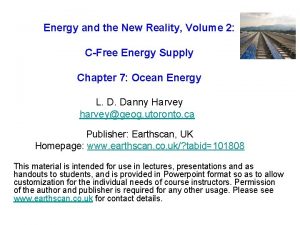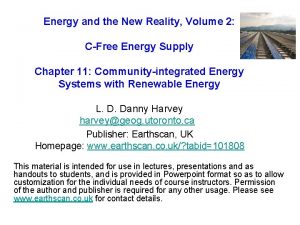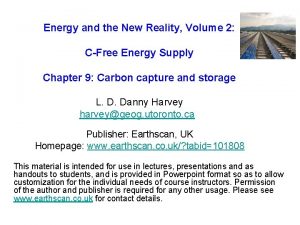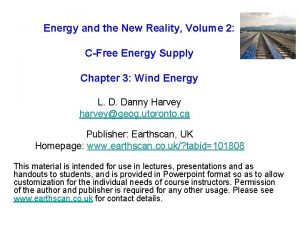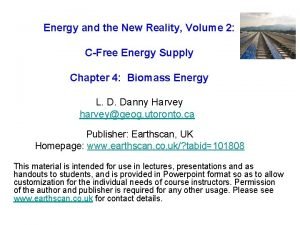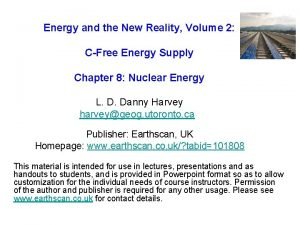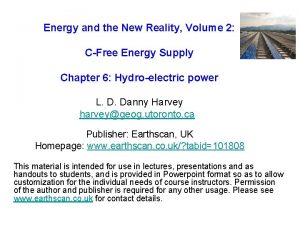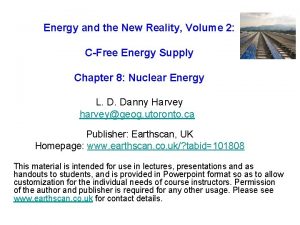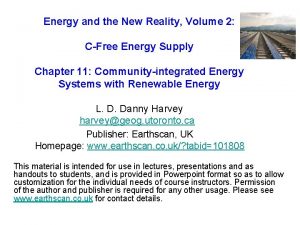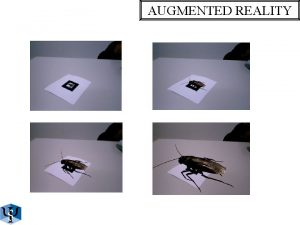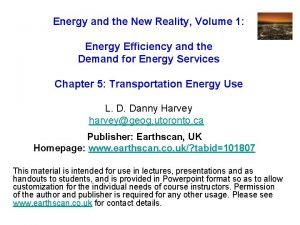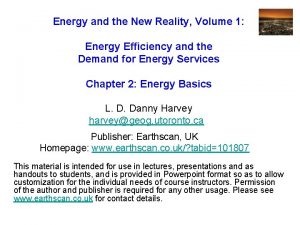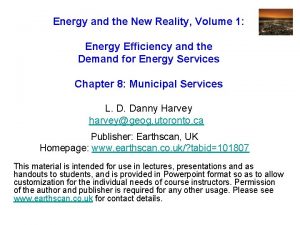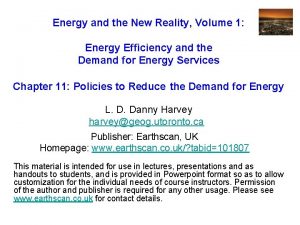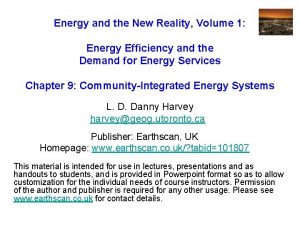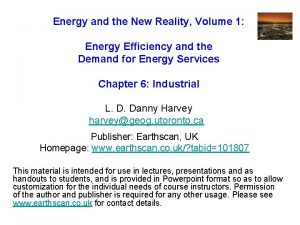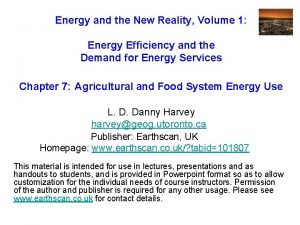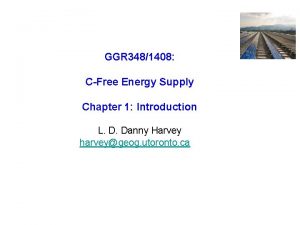Energy and the New Reality Volume 2 CFree









































- Slides: 41

Energy and the New Reality, Volume 2: C-Free Energy Supply Chapter 5: Geothermal Energy L. D. Danny Harvey harvey@geog. utoronto. ca Publisher: Earthscan, UK Homepage: www. earthscan. co. uk/? tabid=101808 This material is intended for use in lectures, presentations and as handouts to students, and is provided in Powerpoint format so as to allow customization for the individual needs of course instructors. Permission of the author and publisher is required for any other usage. Please see www. earthscan. co. uk for contact details.

The temperature increases with increasing depth in the Earth’s crust at a typical rate of 20 K/km

Types of geothermal resources: • Hydrothermal – hot water or steam in confined aquifers, under pressure • Geopressurized – hot, high-pressure brines (saline water) with dissolved methane • Hot dry rock (or “enhanced geothermal systems”, EGS) • Magma

Figure 5. 1 A hydrothermal geothermal resource Source: Barbier (2002, Renewable and Sustainable Energy Reviews 6, 63– 65, http: //www. sciencedirect. com/science/journal/13640321)

Geothermal energy can be used: • Directly for heating • To generate electricity

Geothermal Energy For Electricity Generation (1990 -2014) Source: Renewable Energy World, May-June 2016

Existing and planned (as of end-of-2015) geothermal electricity generation capacity by country 6000 5000 Capacity (MW) Planned (Total = 10. 9 GW) 4000 Existing in 2015 (Total = 13. 3 GW) 3000 2000 1000 Ph U ilip S pi ne Tu s rk e Ke y ny N Me a ew x Ze ico al an Ic d el a Et nd hi op ia Ita ly J El ap Sa an l C vad os o ta r R ic a O th er In do ne si a 0 Source: "2016 Annual US and Global Geothermal Power Production Report"

Figure 5. 2 Agricultural uses of heat

Figure 5. 3 a US subsurface temperature at a depth of 6. 5 km Source: MIT (2006, The Future of Geothermal Energy: Impact of Enhanced Geothermal systems (EGS) on the United States in the 21 st Century)

Figure 5. 3 b Temperatures encountered at a depth of 5 km in Europe Source: GAC (2006, Trans-Mediterranean Interconnection for Concentrating Solar Power, Final Report, GAC)

Figure 5. 4 a Creil geothermal district heating (near Paris) Source: Brown (1996, Renewable Energy, Power for a Sustainable Future, Oxford University Press, Oxford)

Figure 5. 4 b Creil geothermal district heating Note the use of a heat pump to extract extra heat from the 35⁰C water returning from the top set of 2000 apartments, allowing another 2000 apartments to be heated while making the return flow even colder (10⁰C). The colder return flow allows more heat to be extracted from the hot (60⁰C) water taken from the ground before it is returned than would otherwise be possible (the geothermal loop is in contact with 10⁰C water instead of 35⁰C water, and so is cooled down to 25⁰C). Source: Brown (1996, Renewable Energy, Power for a Sustainable Future, Oxford University Press, Oxford)

Technologies for converting geothermal heat into electricity: • Dry steam • Single, double and triple flash - both of these are suited for high__temperature resources • Binary cycle/organic Rankine cycle - can use low-temperature resources (down __to 100⁰C)

Figure 5. 5 a Dry steam geothermal power Source: Brown (1996, Renewable Energy, Power for a Sustainable Future, Oxford University Press, Oxford)

The purpose of the cooling tower shown in the previous slide is to make the steam exiting from the turbine as cool as possible, so that it has low pressure – this allows more energy (as electricity) to be extracted from the turbine). The cooling tower produces cool water by forcing evaporation of some of the water that is fed to it. The water lost through evaporation needs to be continuously replaced. (cooling towers are used in coal and nuclear power plants, which also have steam turbines)

Geothermal power plant with cooling tower

Geothermal power plant with cooling towers

Figure 5. 5 b Single-flash geothermal power Source: Brown (1996, Renewable Energy, Power for a Sustainable Future, Oxford University Press, Oxford)

Figure 5. 5 c Binary-cycle geothermal power (there are two completely separate flow loops, where only heat is transferred between them in a heat exchanger) Source: Brown (1996, Renewable Energy, Power for a Sustainable Future, Oxford University Press, Oxford)

Figure 5. 5 d Double-flash geothermal power Source: Brown (1996, Renewable Energy, Power for a Sustainable Future, Oxford University Press, Oxford)

Figure 5. 6 Enhanced geothermal system (EGS) Source: Mock et al (1997, Annual Review of Energy and Environment 22, 305– 356)

Drilling: • To a depth of 10 km is possible • 6 km might be a limit to the depth that is economical The USGS estimated that EGS between depths of 3 -km could supply 500 GW of power (compared to about 1000 GW total power capacity today in the US). Exploration costs can add up to 15% of the total cost of a geothermal project, and the success rates in the early stages can be only 50 -60% - so early-stage government support is needed to reduce financial risks to investors

Figure 5. 7 a CO 2 emissions Source: Barbier (2002, Renewable and Sustainable Energy Reviews 6, 63– 65, http: //www. sciencedirect. com/science/journal/13640321)

Figure 5. 7 b S emissions Source: Barbier (2002, Renewable and Sustainable Energy Reviews 6, 63– 65, http: //www. sciencedirect. com/science/journal/13640321)

Figure 5. 10 Amount of heat available at different temperatures and at different depths below the US land surface By comparison, total world energy use of all kinds is about 600 EJ/yr Source: MIT (2006, The Future of Geothermal Energy: Impact of Enhanced Geothermal systems (EGS) on the United States in the 21 st Century)

Cost of geothermal power: • The US Department of Energy website gives a capital cost of $3000 -5000/k. W for small (< 1 MW) powerplants • Maintenance costs of 1 -3 cents/k. Wh • Capacity factor of 0. 9 (running the plant more than 90% of the time increases unit maintenance costs) • Result (depending on interest rate and project lifespan): __3 -10 cents/k. Wh (by comparison, both solar PV and onshore wind capital costs are now $1000 -2000/k. W, but these plants have lower capacity factors) However, the given geothermal costs do not include exploration costs and interest incurred during the project development Source: https: //energy. gov/eere/geothermal-faqs#cost_to_develop_geothermal_power_plant

Development of geothermal energy is risky, so investors expect higher returns Source: Nathwani and Mines (2015), https: //pangea. stanford. edu/ERE/db/WGC/papers/WGC/2015/04022. pdf

The “discount rate” is the same as the interest that has to be paid to investors at this stage, and the interest incurred is compounded. Because the early stages occur several years before the project is ready to start producing and selling electricity, and the interest rate is large, these early stages contribute a lot to the final cost of electricity. Source: Nathwani and Mines (2015), https: //pangea. stanford. edu/ERE/db/WGC/papers/WGC/2015/04022. pdf

Sample cost breakdown, for a 30 -MW single flash powerplant operating for 30 years, with wells drilled to a depth of 2 km and 200⁰C: • • Exploration, $3. 7 million Confirmation, $29. 2 million Well field development, $49. 9 million Power plant, $71. 1 million Total, $155. 5 million Total with contingencies, $178. 8 million Total with contingencies and accumulated interest on the loans up to the point of startup, $210. 4 million This is a cost of $7000/k. W, of which direct construction cost is $4000/k. W The final cost of electricity is 10. 9 cents/k. Wh, of which 2. 4 cents/k. Wh are for O&M, insurance, and taxes.

Dependence of costs in the previous example on the temperature at the 2 -km depth (“overnight” cost means the cost without any interest incurred during construction – as if the project could be built overnight and then immediately start selling electricity) Source: Nathwani and Mines (2015), https: //pangea. stanford. edu/ERE/db/WGC/papers/WGC/2015/04022. pdf

From the previous slide, we see that • The warmer the resource, the lower the cost (with hotter water fed into the turbine, the efficiency is higher – so more electricity is produced, thus lowering the cost per k. Wh) • Flash systems, using 170 -250⁰C water, have final costs of 9 -13 cents/k. Wh • Binary-cycle systems, using cooler water (down to 130⁰C), have final costs of 10 -24 cents/k. Wh

Cost to drill a well as a function of depth of well (several production and injection wells would need to be drilled for a 30 MW plant) Source: Nathwani and Mines (2015), https: //pangea. stanford. edu/ERE/db/WGC/papers/WGC/2015/04022. pdf

There will be a tradeoff – deeper wells cost more to drill, but deeper wells will tap hotter water, which increases the electricity generation efficiency and hence electricity production, which reduces the unit cost

Larger projects have smaller unit costs ($/k. Wh), but there is not much cost reduction beyond a size of 30 MW (see the dashed lines in the figure below) Source: Nathwani and Mines (2015), https: //pangea. stanford. edu/ERE/db/WGC/papers/WGC/2015/04022. pdf

Applications of oil and gas industry expertise to geothermal energy: • • • Deep drilling Fracturing of subsurface rocks Use of high-temperature tools Use of fibre-optic cables Preserving the integrity of well holes As well, it might be possible to develop geothermal energy at pre-existing oil and gas wells.

Figure 5. 14 Cost of oil, gas and hot dry rock geothermal wells Source: MIT (2006, The Future of Geothermal Energy: Impact of Enhanced Geothermal systems (EGS) on the United States in the 21 st Century)

Some brines (salty waters) from geothermal wells are a potential source of Li, Mn and Zn. Li is needed in the preferred battery technology, Li-ion. Zn is widely used and is facing shortages in the future. Sale of such minerals would increase the economic viability of geothermal projects with salty brines, while addressing potential mineral shortages (which would be reflected in higher prices for the minerals).

Figure 5. 8 Worldwide direct use of geothermal heat and generation of electricity from geothermal energy

Figure 5. 9 Geothermal share of national electricity production

Source: Renewable Energy World, Jan-Feb 2017

Geothermal projects, 2006 -2015: • 118 binary cycle • 58 flash cycle • 14 dry steam for a total of 4. 4 GW, bringing the total installed capacity to 13. 3 GW (By comparison, total wind capacity at the end of 2016 was almost 500 GW and total solar just over 300 GW – for a total wind and solar of 800 GW)
 Energy energy transfer and general energy analysis
Energy energy transfer and general energy analysis Energy energy transfer and general energy analysis
Energy energy transfer and general energy analysis End-diastolic volume vs end-systolic volume
End-diastolic volume vs end-systolic volume Stroke volume normal
Stroke volume normal Volume of solute divided by volume of solution * 100
Volume of solute divided by volume of solution * 100 Lung capacity
Lung capacity Volume kerucut = .....x volume tabung *
Volume kerucut = .....x volume tabung * Define large volume parenterals
Define large volume parenterals Hình ảnh bộ gõ cơ thể búng tay
Hình ảnh bộ gõ cơ thể búng tay Slidetodoc
Slidetodoc Bổ thể
Bổ thể Tỉ lệ cơ thể trẻ em
Tỉ lệ cơ thể trẻ em Voi kéo gỗ như thế nào
Voi kéo gỗ như thế nào Chụp phim tư thế worms-breton
Chụp phim tư thế worms-breton Alleluia hat len nguoi oi
Alleluia hat len nguoi oi Kể tên các môn thể thao
Kể tên các môn thể thao Thế nào là hệ số cao nhất
Thế nào là hệ số cao nhất Các châu lục và đại dương trên thế giới
Các châu lục và đại dương trên thế giới Công của trọng lực
Công của trọng lực Trời xanh đây là của chúng ta thể thơ
Trời xanh đây là của chúng ta thể thơ Cách giải mật thư tọa độ
Cách giải mật thư tọa độ Làm thế nào để 102-1=99
Làm thế nào để 102-1=99 Phản ứng thế ankan
Phản ứng thế ankan Các châu lục và đại dương trên thế giới
Các châu lục và đại dương trên thế giới Thơ thất ngôn tứ tuyệt đường luật
Thơ thất ngôn tứ tuyệt đường luật Quá trình desamine hóa có thể tạo ra
Quá trình desamine hóa có thể tạo ra Một số thể thơ truyền thống
Một số thể thơ truyền thống Cái miệng nó xinh thế
Cái miệng nó xinh thế Vẽ hình chiếu vuông góc của vật thể sau
Vẽ hình chiếu vuông góc của vật thể sau Thế nào là sự mỏi cơ
Thế nào là sự mỏi cơ đặc điểm cơ thể của người tối cổ
đặc điểm cơ thể của người tối cổ Thứ tự các dấu thăng giáng ở hóa biểu
Thứ tự các dấu thăng giáng ở hóa biểu Vẽ hình chiếu đứng bằng cạnh của vật thể
Vẽ hình chiếu đứng bằng cạnh của vật thể Fecboak
Fecboak Thẻ vin
Thẻ vin đại từ thay thế
đại từ thay thế điện thế nghỉ
điện thế nghỉ Tư thế ngồi viết
Tư thế ngồi viết Diễn thế sinh thái là
Diễn thế sinh thái là Các loại đột biến cấu trúc nhiễm sắc thể
Các loại đột biến cấu trúc nhiễm sắc thể Số.nguyên tố
Số.nguyên tố Tư thế ngồi viết
Tư thế ngồi viết










































